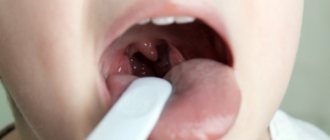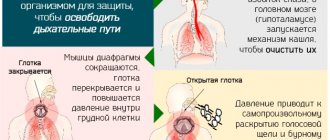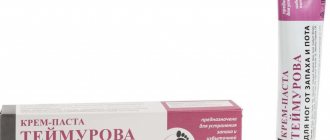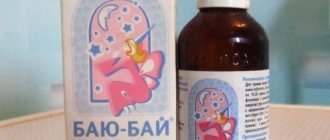Bronchopulmonary diseases in children are often accompanied by narrowing of the airways and associated difficulty in the passage of air (obstructive syndrome). To eliminate this dangerous symptom, Berodual is used, an inhalation solution that can relax the smooth muscles of the bronchial tree, reduce the production of secretions in the bronchi, and also significantly facilitate breathing. Despite the fact that this drug is a non-hormonal medication, you should read the instructions for use and the features of its use - this will help make the treatment as effective as possible, but not harm the baby.
Pharmacological properties of the drug Berodual n
Berodual N contains two active bronchodilator ingredients: ipratropium bromide, which has an anticholinergic effect, and fenoterol hydrobromide, which is a β-adrenergic agonist. Ipratropium bromide is a quaternary ammonium compound with anticholinergic (parasympatholytic) properties. Inhibits vagal reflexes due to antagonistic interaction with acetylcholine, a mediator that ensures the transmission of impulses in the vagus nerve. Anticholinergics prevent the increase in intracellular concentrations of cGMP, which occurs due to the interaction of acetylcholine with muscarinic smooth muscle receptors. Bronchodilation after inhaled administration of ipratropium bromide is mainly due to the local specific effect of the drug. In patients with bronchospasm caused by COPD (chronic bronchitis and emphysema), there was a significant improvement in lung function within 15 minutes after using the drug (increase in forced expiratory volume in 1 second and average forced expiratory volumetric flow rate in the range of 25–75% forced expiratory vital capacity of the lungs (by 15% or more); the maximum effect is observed after 1–2 hours and in most cases lasts up to 6 hours. After using Berodual N for bronchospasm caused by asthma, a significant improvement in lung function (increase in forced expiratory volume1 by 15% and more) noted in 40% of patients. Ipratropium bromide does not have a negative effect on mucus secretion in the respiratory tract, mucociliary clearance and gas exchange in the lungs. Fenoterol hydrobromide is a sympathomimetic, in a therapeutic dose it selectively stimulates β2-adrenergic receptors, but when used in higher doses has a stimulating effect on β1-adrenergic receptors.Binding to β2-adrenergic receptors leads (with the help of the activating Gs protein) to the activation of adenylate cyclase. When the level of cAMP increases, protein kinase A is activated and the corresponding proteins are phosphorylated in smooth muscle cells, which in turn leads to the phosphorylation of myosin light chain kinase, blocking the hydrolysis of phosphoinositide and the opening of calcium-dependent potassium channels. Fenoterol causes relaxation of the smooth muscles of the bronchi and blood vessels and prevents bronchospasm caused by the effects of bronchoconstrictor agents (histamine, methacholine, cold air and allergens). Fenoterol blocks the release of bronchoconstrictor and proinflammatory mediators. When the drug was administered in high doses, an improvement in mucociliary clearance was noted. At higher concentrations of fenoterol in the blood plasma, which is usually achieved by oral administration or intravenous administration, the contractile activity of the myometrium is reduced. When using the drug in high doses, its metabolic effect may occur: lipolysis, glycogenolysis, hyperglycemia and hypokalemia, the latter caused by an increase in the uptake of K+ ions by cells, especially skeletal muscles. The effect of fenoterol on myocardial β2-adrenergic receptors is accompanied by tachycardia and an increase in the force of heart contractions, which is associated with the vascular effect of fenoterol, stimulation of cardiac β2-adrenergic receptors, and in doses exceeding therapeutic doses - stimulation of β1-adrenergic receptors. As with the action of other β-adrenergic substances, a prolongation of the Q-Tc . For fenoterol, these indicators are discrete and are recorded at doses exceeding the recommended ones. The clinical significance of this has not been established. The side effect most often reported with β-sympathomimetics is tremor. In contrast to the effect on bronchial smooth muscle, the systemic effects of β-sympathomimetics are a reason for the development of tolerance. Fenoterol prevents the development of bronchospasm caused by various factors, such as physical activity, cold air, as well as the influence of allergens (immediate reaction). With the simultaneous use of two bronchodilators, bronchial dilation occurs due to the implementation of two different pharmacological mechanisms. The mechanism of action of this combination of drugs allows them to be widely used for diseases of the bronchopulmonary apparatus associated with obstruction of the airways. Thus, the two active substances have a synergistic bronchodilator effect, which allows them to be used in a proportionally reduced dose and, therefore, reduce the risk of side effects. According to clinical studies, in patients with asthma and COPD, Berodual N corresponds in effectiveness to a double dose of fenoterol prescribed without ipratropium bromide, but has better tolerance with long-term use. In case of bronchospasm, the effect of Berodual N develops immediately after administration, so the drug can be used to relieve asthma attacks. Pharmacokinetics. The therapeutic effect of Berodual N manifests itself through a local effect on the respiratory tract. After inhalation, about 16% of the drug settles in the respiratory tract, the rest is swallowed. The active ingredients are absorbed very quickly in the respiratory tract, their maximum concentration in the blood plasma is reached within a few minutes. There is no evidence that the pharmacokinetics of the combination of both ingredients differs from that of each monosubstance. Fenoterol hydrobromide , which enters the digestive tract, is mainly metabolized to sulfate conjugates. Bioavailability after oral administration is low (about 1.5%). Fenoterol and its conjugates are rapidly excreted in the urine (renal clearance - 267 ml/min). About 40–55% of the drug binds to blood plasma proteins. In the unmetabolized state, fenoterol hydrobromide can slowly penetrate the placental barrier and enter breast milk. Ipratropium bromide . Absolute bioavailability after oral administration is about 2%. The half-life in the terminal elimination phase is about 1.6 hours. The total clearance is 2.3 l/min. About 40% of the drug is excreted in the urine (renal clearance - 0.9 l/min), 60% undergoes hepatic clearance. The main metabolites detected in urine bind to muscarinic receptors to a small extent. Renal excretion of unchanged active substance is 4.4–13.1% of the dose after inhalation. The drug minimally (less than 20%) binds to blood plasma proteins. Ipratropium ion does not penetrate the BBB; it is not known whether it penetrates the placental barrier.
Drug interactions
To enhance the therapeutic effect, several drugs are combined in inhalations.
How to dilute with Lazolvan - proportions and doses
Thus, the use of Lazolvan (mucolytic) in one inhalation with Berodual is considered effective. To do this, add 1-2 ml (depending on the indications and age) of Lazolvan to the recommended ratio of saline and Berodual. But much more often, alternating these medications is practiced - first, the child breathes Berodual, which dilates the bronchi, and after 15-20 minutes, inhalation is carried out with a mucolytic, which allows you to effectively remove accumulated sputum.
Inhalations with mucolytic agents should be carried out no later than 2 hours before the child goes to bed - this can lead to an active night cough or stagnation of sputum.
Is it possible to do inhalations with Pulmicort for infants?
In some cases, children are prescribed a combination of Berodual with Pulmicort, a glucocorticosteroid that reduces allergic manifestations and eliminates swelling of the mucous membranes. However, it is strictly not recommended to mix these two drugs, since Pulmicort will increase the effect of Berodual and, accordingly, increase the risk of side effects. The following combination scheme is optimal: inhalation of Pulmicort, and an hour later – inhalation with Berodual.
Price – about 800 rubles
Use of the drug Berodual n
The dose is set individually. For adults and children over the age of 6 years, the following dosage regimens are recommended: relief of an acute attack of asthma: usually 2 inhalations are sufficient; for severe attacks, if breathing does not improve significantly within 5 minutes, 2 additional inhalations can be performed. If there is no effect after 4 inhalations, it may be necessary to take additional measures. In such cases, the patient should immediately consult a doctor or the nearest medical facility. Intermittent and long-term use: 1-2 inhalations for each procedure, no more than 8 inhalations per day (on average - 1-2 inhalations 3 times a day). In children, dosed aerosol Berodual N should be used only under adult supervision. Aerosol injection. To achieve maximum effect, patients should be instructed regarding the correct use of the metered dose aerosol. Before using the drug in this form for the first time, press the valve twice until a cloud of aerosol appears. Before each use, you must follow the following rules: remove the protective cap, exhale slowly, hold the canister upside down (with the inhalation device facing down), wrap your lips around the tip, inhale as deeply as possible, and simultaneously press the bottom of the canister until one measured dose is released. Hold your breath for a few seconds, then remove the tip from your mouth and exhale slowly. After use, put on the protective cap. If the dosed canister has not been used for more than 3 days, before use, press the valve once until an aerosol appears. The cylinder is designed for 200 doses (inhalations). After using 200 doses, the balloon should be replaced. Although some contents still remain in the balloon, the amount of drug released during inhalation is not sufficient to achieve a therapeutic effect. The tip should be kept clean and, if necessary, can be rinsed with warm water. After using soap or detergent, the handpiece must be rinsed thoroughly with clean water.
How to do inhalations with Berodual and saline solution for children - instructions for use, dosages
Berodual for inhalation is a concentrated solution, and therefore requires connection with saline solution. The amount of medication recommended by the doctor is taken into the appropriate nebulizer reservoir, and then 2-3 ml of sodium chloride is added. The average age dosages of Berodual and the frequency of the procedure are as follows:
- Children from birth to 6 years
– 1 drop of the drug per 2 kg of weight (but not more than 10 drops). 3 procedures per day are allowed. In this case, both infants and preschoolers should inhale the product for 5-7 minutes - this is exactly how long it will take for complete evaporation from the reservoir. - Children from 6 to 12 years old
are prescribed 10 drops of Berodual for treatment at home; in severe cases and only in hospital conditions, the volume of medication can reach 40-50 drops at a time. Inhalation is carried out 3-4 times a day for 7-10 minutes. - Adolescents 12-17 years old
are prescribed from 20 (for mild cases) to 80 (for particularly severe conditions) drops per inhalation.
The duration of the treatment course is 3-5 days. For each procedure, it is necessary to prepare a new solution - preparing it in reserve or using leftovers from a previous inhalation is strictly prohibited.
In severe cases, more frequent inhalations may be prescribed. But the interval between them must be at least 4 hours.
Side effects of the drug Berodual n
The most common symptoms are fine tremor of skeletal muscles and increased excitability, a feeling of dry mouth, and in some cases headache, dizziness, and tachycardia. There are isolated reports of side effects from the organ of vision, including impaired accommodation and glaucoma (see SPECIAL INSTRUCTIONS). Very rarely, allergic reactions are possible: skin rash, angioedema of the tongue, lips and face, urticaria, laryngospasm and anaphylactic reactions. Severe hypokalemia may potentially result from β2-agonist therapy. As with the use of other inhaled drugs, coughing, local irritating effects (for example, pharyngitis, throat irritation), and in some cases bronchospastic reactions were noted. As with the use of other β-adrenergic agonists, Berodual N can cause nausea, vomiting, increased sweating, general weakness, myalgia and spasms. Very rarely, when used in high doses, a decrease in diastolic blood pressure, an increase in systolic blood pressure, arrhythmias, atrial fibrillation and supraventricular tachycardia are observed. In some cases, the development of mental changes under the influence of inhaled therapy with β-adrenergic agonists was reported. Disturbances of accommodation, motility of the digestive tract and urinary retention are rare and are reversible.
Special instructions for use
During pregnancy and breastfeeding. Experimental and clinical studies have not revealed a negative effect of fenoterol and ipratropium bromide on the course of pregnancy and the fetus, however, its use during pregnancy, especially in the first trimester, is not recommended. The effect of fenoterol on uterine contractility during labor should be taken into account. Preclinical studies have shown that fenoterol passes into breast milk. There is no data on the penetration of ipratropium bromide into breast milk. Although fat-insoluble quaternary bases pass into breast milk, it is unlikely, especially when using the aerosol form of the drug, that ipratropium bromide will have a significant effect on the fetus. However, Berodual N should be used with caution during breastfeeding. When using the new dosage form of Berodual N metered aerosol for the first time, patients may note that it tastes slightly different from the previous dosage form of the drug, which contains freon. The patient should be informed that these dosage forms are interchangeable and taste properties are not relevant to the safety and effectiveness of the new dosage form of the drug. In case of acute dyspnea (difficulty breathing), especially if it progresses rapidly, you should immediately consult a doctor. One should remember the need for basic anti-inflammatory therapy in patients with asthma and steroid-dependent forms of COPD. Long-term use:
- in patients with asthma and non-severe forms of COPD, preference is given to using the drug “as needed” (symptomatically oriented depending on the manifestation of symptoms), rather than regular use;
- In patients with severe asthma or steroid-dependent forms of COPD, anti-inflammatory therapy should be administered to control the inflammatory process in the airways and the course of the disease.
Regular use of a drug in high doses containing β2-agonists, such as Berodual N, to eliminate bronchial obstruction can cause uncontrolled worsening of the disease. In the case of increased bronchial obstruction, increasing the dose of β2-agonists above the recommended long-term is not only not justified, but also dangerous. To prevent worsening of the disease, the treatment regimen should be revised towards adequate anti-inflammatory therapy with inhaled corticosteroids. Other sympathomimetic bronchodilators are prescribed simultaneously with Berodual N only under medical supervision. Berodual N can be prescribed only after careful comparison of the expected benefits and possible risks in the following conditions: diabetes mellitus without proper compensation, recent myocardial infarction and other severe organic diseases of the heart and blood vessels, thyrotoxicosis, pheochromocytoma. When using β2-agonists, significant hypokalemia may develop. Berodual N should be prescribed with caution to patients with benign prostatic hyperplasia and urodynamic disorders, as well as to patients with angle-closure glaucoma. There are reports of isolated cases of complications from the organ of vision (mydriasis, increased intraocular pressure, angle-closure glaucoma, eye pain) that occurred as a result of contact with the eyes of an aerosol of ipratropium bromide or its combination with β2-agonists. Signs of an acute attack of angle-closure glaucoma may include pain in the eyes, blurred vision, a sensation of a halo or colored spots in front of the eyes in combination with conjunctival or corneal hyperemia. If these symptoms occur, miotic drugs should be prescribed and specialized medical care should be sought immediately. Patients with cystic fibrosis are prone to developing gastrointestinal motility disorders when using the drug. Very rarely, after taking Berodual N, hypersensitivity reactions such as urticaria, angioedema, skin rash, bronchospasm, oropharyngeal edema and anaphylactic reactions may immediately develop. Warning: the plastic tip is designed specifically for metered-dose aerosol Berodual N and is used for precise dosing of the drug. The tip should not be used with any other metered-dose aerosols. The contents of the can are under pressure. Do not open the can or expose it to temperatures above 50 °C.
Interactions of the drug Berodual n
The simultaneous administration of β-adrenergic agonists for systemic use, anticholinergics and xanthines (theophylline) can increase the bronchodilator effect of Berodual N and lead to an increase in the severity of side effects. A significant reduction in the bronchodilator effect of Berodual N is possible with simultaneous administration of β-adrenergic receptor blockers. The severity of hypokalemia caused by the use of β-adrenergic agonists may increase with the simultaneous administration of xanthines, corticosteroids and diuretics. This fact should be given special attention when treating patients with severe forms of airway obstruction. Hypokalemia may lead to an increased risk of arrhythmias in patients using digoxin. In this case, it is recommended to monitor the level of potassium in the blood serum. Beta-adrenergic agents should be prescribed with caution to patients taking MAO inhibitors and tricyclic antidepressants, since these drugs may increase the severity of the action of beta-adrenergic agents. Inhalation of halogenated carbohydrate anesthetics, such as halothane, trichloroethylene or enflurane, may enhance the cardiovascular effects of beta-adrenergic agents.
Possible analogues, cost of medicine
The average cost of Berodual in domestic pharmacies is 240-290 rubles. If it is impossible to purchase or use it, the doctor may decide to replace it with another product with a similar effect:
- Atrovent;
- Berotek;
- Budesonide;
- Ventolin;
- Ditek;
- Ipravent;
- Ipramol Steri-Neb;
- Combivent;
- Seretide.
It is strictly forbidden to independently select a drug for inhalation for a child, since each of the above analogues has age restrictions and a number of contraindications.
Overdose of the drug Berodual n
It is caused mainly by the action of fenoterol and excessive stimulation of β-adrenergic receptors. The most likely symptoms are tachycardia, palpitations, tremor, hypertension (arterial hypertension) or hypotension, increased pulse pressure, angina attacks, arrhythmia and flushing. Symptoms of an overdose of ipratropium bromide (a feeling of dryness of the oral mucosa, impaired accommodation) are usually mild and transient due to the very low systemic bioavailability of inhaled ipratropium bromide. Treatment: administration of sedatives, tranquilizers, and in severe cases, intensive care. β-adrenergic receptor blockers, preferably β1-selective, are used as specific antidotes; however, the dose should be carefully selected for patients with asthma or COPD, taking into account the possibility of increased bronchial obstruction under their influence, even death.







